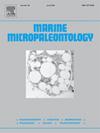利用有孔虫评估中全新世以来巴拿马加勒比海沿海生境的变化
IF 1.5
4区 地球科学
Q2 PALEONTOLOGY
引用次数: 0
摘要
公元前 690 年,人类在巴拿马加勒比海的博卡斯德尔托罗群岛定居。19 世纪 80 年代末,沿海土地被开垦为农业用地,近几十年来发现水质有所下降。为了研究支持水质下降的变化,并评估因开垦地径流增加而造成的盐度差异,阿尔米兰特湾的底栖有孔虫作为环境替代物,用于比较现代和中全新世时期。有孔虫群落的物种和多样性在两个时代的栖息地之间有相当大的重叠,不同时代之间物种比例的差异比任何一个时代的栖息地之间的差异都大。这些模式反映了在这种淤积的片礁环境中,相邻栖息地之间的高度连通性。来自中全新世软体动物淤泥和现代红树林的组合物的多样性最少,与海草和珊瑚栖息地的组合物相当相似,且差异较大。有孔虫壁结构表明,现代有更多的淡水输入,这与为农业而砍伐森林是一致的,尽管这两个时代都属于正常盐度的低端。淡水输入的增加影响了生物群落的变化,但不足以减少测量到的多样性。据报道,海湾水质的下降也没有导致有孔虫多样性的净损失,这表明这些极浅的热带沿岸群落具有很强的恢复能力。本文章由计算机程序翻译,如有差异,请以英文原文为准。
Using foraminifera to assess changes in marine coastal habitats of Caribbean Panama since the Middle Holocene
Humans settled the Bocas del Toro archipelago of Caribbean Panama ∼690 CE. Coastal land was cleared for agriculture in the late 1880s and in recent decades water quality degradation has been detected. To investigate changes that support a decline in water quality and to assess differences in salinity caused by increased runoff from cleared lands, benthic foraminifera of Almirante Bay served as an environmental proxy to compare modern and Middle Holocene times. The foraminiferal community structure of 17 modern mangrove, seagrass, and coral reef habitats <2 m deep was analyzed in combination with 18 samples of ∼6600-year-old coral reef, seagrass and muddy molluscan biofacies from Isla Colón island.
The foraminiferal communities' species and diversity overlap considerably among habitats of both ages, and there is more difference in species' proportions between the ages than among habitats of either age. These patterns reflect high connectivity across adjacent habitats in this embayed, patch-reef setting. Assemblages from Middle Holocene molluscan muds and modern mangroves are least diverse, fairly similar, and well differentiated from those of seagrass and coral habitats. Foraminiferal wall structure suggests more freshwater input in modern times, consistent with forest clear-cutting for agriculture, although both ages fall within the low end of normal salinity. Increased freshwater input influenced assemblage changes but they were not sufficient to reduce measured diversity. Reported declines in the bay's water quality have also not resulted in net foraminiferal diversity loss from ∼6600 years ago, indicating substantial resilience in these extremely shallow, tropical coastal communities.
求助全文
通过发布文献求助,成功后即可免费获取论文全文。
去求助
来源期刊

Marine Micropaleontology
地学-古生物学
CiteScore
3.70
自引率
15.80%
发文量
62
审稿时长
26.7 weeks
期刊介绍:
Marine Micropaleontology is an international journal publishing original, innovative and significant scientific papers in all fields related to marine microfossils, including ecology and paleoecology, biology and paleobiology, paleoceanography and paleoclimatology, environmental monitoring, taphonomy, evolution and molecular phylogeny. The journal strongly encourages the publication of articles in which marine microfossils and/or their chemical composition are used to solve fundamental geological, environmental and biological problems. However, it does not publish purely stratigraphic or taxonomic papers. In Marine Micropaleontology, a special section is dedicated to short papers on new methods and protocols using marine microfossils. We solicit special issues on hot topics in marine micropaleontology and review articles on timely subjects.
 求助内容:
求助内容: 应助结果提醒方式:
应助结果提醒方式:


